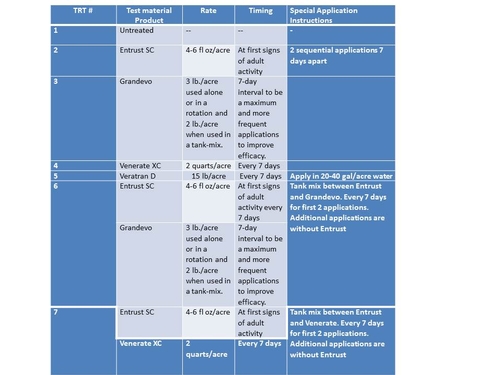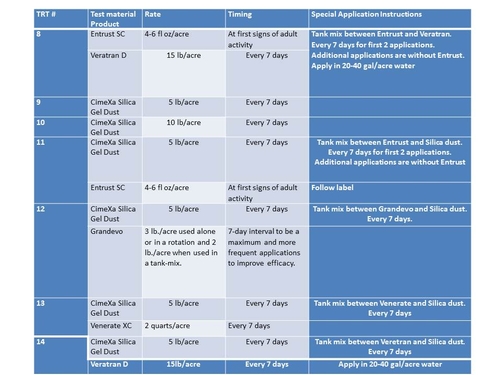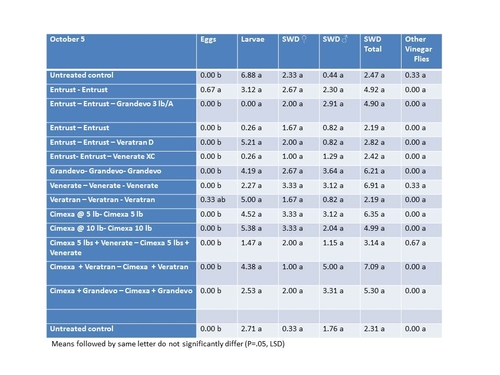Posts Tagged: organic
Big Bounce in Organic Berry Sales
This just out of Growing Produce magazine:
http://www.growingproduce.com/vegetables/organic-fruit-sales-surge-12/
"While berries as a whole have been on a strong upward trend for some time, organic growth continues to be at a faster pace than its conventional counterparts."
Year over year sales in organic berries have surged 22% in dollar value and 16% in volume.
The last paragraph of the article is probably the most informative, as it quotes retailers stating that the biggest hurdle to growing sales in organic is cost, indeed finding the "sweet spot" between convenience and fair pricing (is the implication that pricing is currently NOT fair!?) will be the key to future growth in this space.
Answering the Question of Sustainability Problems of 'Repackaged' Synthetic Nitrogen in Organic Agriculture
Mark here. The video by Dr. Eric Brennan concerning the sustainability problems of using what is essentially repackaged synthetic nitrogen in organic agriculture that I posted a few weeks ago has sparked a lot of discussion in my social circles, most recently for me at a dinner with a big ag company and a local PCA specializing in organic consultation. These conversations turn around the same point that reader Thomas Flewell (Thom - note you got your byline!) brings up below. Best to go to the expert on this very subject so I asked Dr. Brennan if couldn't answer the question for all of us, and he graciously accepted my invitation to do so.
Follow along below:
Thomas Flewell: Preface- As the world population approaches 9 billion within the next 100 years, it is clear that organic farming will not serve up enough food for everyone.
Dr Brennan's reasoning toward the use of synthetic nitrogen in organic farming is persuasive but I see an error of omission. Dr Brennan failed to note that manure derived fertilizer will be produced whether or not it is used for agriculture. Cows poop. Chickens poop. Pigs poop. Goats poop. All god's creatures poop. And none of them are raised only to produce fertilizer. So the energy to produce argument seems weak. Also, while manures are used as pre-plant fertilizer and in some instances as a top dress or side dress for crops, fish fertilizers are also used. I have had very good results with a hydrolyzed (not emulsified) fish fertilizer with a very low N analysis. Perhaps just an academic point.
Eric Brennan:
Hi Thomas,
Thanks for your interest in my ‘repackaged' synthetic nitrogen video and for your comments on it. I've heard others raise similar questions after seeing my video. I'm working on an opinion paper that will provide more details on the arguments that I raise in the video, and hopefully will bolster my arguments with citations, and examples that I was able to fit into the video. But in the meantime here are some ideas to consider and some articles to help with that.
I agree on the value and importance of recycling nutrients from manure and animal slaughter by-products; to my knowledge slaughter by-products are more important than manure in high-value organic crops California. However, I imagine that rendering process (extraction, grinding, heating, pressing, etc.) to convert this material into pelleted fertilizers takes a fair bit of energy to ensure that the material is safe to use, and easy to handle and apply. And transporting this bulky material to where it's used is also energy-intensive. Consider an organic system in a place like my home state of Hawai'i where there is relatively limited animal production. Think of the energy costs to move organic fertilizer made of chicken manure, meat, bone, and feather meal all the way from California, for use on an organic farm in Hawai'i! To me, this seems like a relatively inefficient way to get N in these systems.
Ideally these animal production by-products could be used in organic and conventional systems near to where they are produced and in systems that need the full suite of nutrients they contain; even better would be for the nutrients in these materials to return to the systems that produced the feed for these animals. But having to rely heavily or almost exclusively on this type of fertilizer material (as in often the case in organic vegetable production in many regions) for nutrients like nitrogen (N) can be problematic and quite expensive. As I mentioned in the video, one problem is that N in many of these ‘repackaged' synthetic N fertilizers often come with excessive amounts of phosphorous (P) that far exceed what is being removed from the soil in crop yields. I became well aware of this issue of excessive P inputs in my research when I collaborated with researchers from Stanford and UC Davis to calculate P budgets (P inputs versus P outputs) in two long-term organic studies in California. This is described in detail in the a few publications like this one available here. To improve our P budgets in our long-term study in Salinas we switched from using pre-plant fertilizers with a 4-4-2 analysis to an pre-plant with a 8-1-1 analysis which was more expensive per unit of N; from what I've seen with pelleted organic fertilizers, unfortunately the materials with lower P or no P have a higher per unit cost for N. Switching to 8-1-1 helped with our P budgets, but we still were applying more P than needed when we added yard-waste compost to these systems. This improvement in our P budget is very obvious in figure 2B in of the paper note above that shows a big decline from 2007 to 2008 in the P balance. This also highlights the importance using cover crops to add carbon back to the soil, rather than over relying on compost which can add too much P. Carbon added by cover crops represents ‘on-farm carbon production' that doesn't add P, but just recycles what's already in the soil to produce the organic matter. Furthermore, organic matter inputs from cover crops appear to be a more important driver of soil health improvement than organic matter from compost. Here's our recent paper that describes that issue
Getting back to the P budget issue, during 8 years of our long-term trial on high-value vegetable production, we added more than 400 lbs of P per acre than was needed to replace what was removed in exported yields ! It's important to highlight that unlike N that we can capture out the air with biological N fixation (using legumes) and by synthetic fixation (using the Haber-Bosch process), P is a limited, mined nutrient, and there is considerable concern about the worlds dwindling P reserves; this highlights why we should only apply P when needed. Here's a link to another paper from our long-term study that provides some information the biological N fixation potential from legume-cereal cover crop mixture in these systems. While legumes do fix N in these systems, this is limited by their ability to complete with non-legumes likes cereals that provide other important services like nitrogen scavenging from previous vegetable crops, … and there can be other challenges with legume-cereal cover crops that I highlighted in this video Are legume-cereal cover crops a good fit for organic vegetable production?
Another issue to consider with organic soil fertility management that is relevant to the arguments in my ‘repackaged' synthetic N video is the total supply of manure and slaughter by-product based fertilizers available in a region like California. I don't know the extent of this supply, but it seems likely that as organic agriculture acreage grows here and uses more of these organic fertilizers, this supply of fertilizer will become more and more limited unless animal production (that relies primarily on feed grown synthetic N) increases. This is concerning because the science of climate change indicates the need for people in regions like the U.S., with excessive protein consumption, to reduce consumption of animal products. This important dietary shift to less meat consumption would likely reduce the amount of manure and slaughter by-products available for recycling as fertilizers. Furthermore, relying on fish as source of N for organic agriculture could overtax the world's oceans that are already over fished in many regions. Perhaps I'm wrong, but I don't believe there is a sound scientific basis for a total ban on the use of pure synthetic nitrogen in organic agriculture. That's why I argued for what I call ‘SPorganic' (i.e., scientifically progressive organic) agriculture that would allow the careful use of synthetic N in it's pure form, rather than only in the ‘repackaged' synthetic forms that are currently allowed in organic systems. However, I believe that limiting the use of N inputs (from ‘repackaged' and pure synthetic forms) and greater adoption of best-management practices like cover cropping, make scientific sense. ‘Enriching the Earth' by Vaclav Smil is a book that I highly recommend for additional reading on the complex issue of nitrogen in agriculture and how the Haber-Bosch process has transformed our lives and accounts for at least 40% of the world's dietary protein. Here's link to an entertaining RadioLab podcast on the Haber-Bosch story that you might also enjoy.
My N video was first presented along with 10 other 5 minute videos at a 2016 symposium that I helped organize at the American Society of Agronomy conference; here' a link to the 11 videos. One of my intentions with my N video was to start a conversation around a complex issue that I believe limits the sustainability of organic systems like those that I work with in California. Thanks for joining that conversation.
Take care, Eric Brennan
Mark here - thanks Thom and Eric for a most informative exchange - really appreciate it!!
Sustainability Problems with 'Repackaged' Synthetic Nitrogen in Organic Agriculture
Should we be able to use synthetic fertilizers in organic agriculture since the organic ones we can use in these systems are repackaged synthetics anyway? This was discussed at a really great lunch meeting today with scientists and growers (THANK YOU Mark C.!), and it's something that is really thought provoking. Watch the video (it's only 5 min), Dr. Brennan can explain way better than I can. Give it some thought.
H/T Eric Brennan.
Comments welcome.
Two Webinars on Spotted Wing Drosophila Management
Readers might be interested in attending either or both of the following webinars coming up in the next few weeks:
Making the Most of Your Insecticide Toolbox to Manage SWD: Jan. 25, 2017, at 8:30 9:00 am PST
Will provide recommendations for growers to prepare for the 2017 growing season.
Registration is free, but you must register: https://msu.zoom.us/webinar/register/5c0227f576a61869d746f627e8486654
Organic Management of SWD: February 1
Join eOrganic for a webinar on organic management of Spotted Wing Drosophila on February 1, 2017, at 2PM Eastern Time, 1PM Central, 12PM Mountain, 11AM Pacific Time. The webinar is free and open to the public, and advance registration is required.
Registration is free, but you must register: https://attendee.gotowebinar.com/register/8379387290681616900
Efficacy and Phytotoxicity of Biopesticides for Management of Spotted Wing Drosophila (SWD) in Raspberries.
JUSTIFICATION AND OBJECTIVES:
IR4, the branch of the USDA focused on speciality crops, identified research on SWD as a priority need. The purpose of this efficacy and crop safety trial was to determine the level of SWD control by organically registered biopesticides in caneberries to determine the impact on plant and yield variables.
TEST SYSTEM DESIGN and STATISTICAL METHOD:
The test site consisted of three replicates of each treatment in Table 1 below. Plots in the active organic raspberry ranch were arranged in a randomized complete block design. Since SWD is a mobile pest, the 3 replicate plots of each treatment (see Table 1 below) were large, consisting of three raspberry hedgerows across, being 54 ft long and 14 feet wide (756 ft2). Statistical analysis was done on ARM, version 9.
TEST SUBSTANCE APPLICATION:
All test substances were applied with a motorized Maruyama 058 backpack sprayer with a hand gun at a pressure of approximately 120 psi. Each material was mixed in a water carrier rate of 75 gpa. Three total applications were done; beginning 9/17/2015, 9/25/2015 and 9/30/2015. Because of excessive residues for the Cimexa Gel material and request of the collaborating grower that this material no longer be applied, no applications of any treatment of Cimexa Gel were made on the last date.
INSECT AND YIELD EVALUATION:
One day prior to the first application of September 17, samples of 10 marketable fruit were collected from each replicate plot and further a section of 18 ft long from the center hedgerow was vacuumed with a Bug-vac for adults. Fruit were held for several days and then each evaluated under the dissecting scope for SWD larvae and eggs. The vacuum sample was evaluated for female and male SWD, along with other insects taken in the sample.
Subsequent sampling and evaluation dates were Sept 22 (pre-sampling), Sept 28, Oct 5 and Oct 16. The sampling date for October 5, taking place after full application of all treatments and thereby likely to give the most meaningful results, is given below. Note that no evaluations were done of treatments containing Cimexa Gel on the last sampling date.
SUPPLEMENTAL CROP TREATMENTS:
No supplemental treatments of any kind were made to the crop during the course of this study.
DISCUSSION:
While there was a tendency for treatments containing Entrust to have lower numbers of larvae found in fruit as other treatments after completion of all three applications on the Oct 5 sampling date, none of these differences are statistically significant and as such regarded with caution.
Furthermore, the residue of CimeXa Silica Gel Dust on leaves, canes and fruit of plants subjected to its application was unacceptable and as such this material is not recommended for further study.
Hat tip to research assistants Don Yoshimura and Monise Sheehan, without whom I could not have possibly done this trial.

Treatments 1- 7 for 2015 SWD Biopesticide Trial

Treatments 8-14 for 2015 SWD Biopesticide Trial

October 5 Results of 2015 SWD Biopesticide Study.

